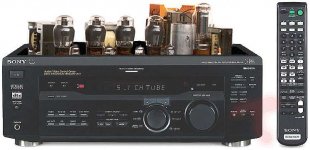I am a slacker, and I like my hi-fi convenient. I like remote controls for volume, sources and also to skip tracks.
So I was thinking to myself, why not build a tube amp that incorporates a remote control?
The easiest way to do this would be probably to use a consumer amplifier (or reciever), with a motorised volume control and relay-switched source inputs. Then simply disconnect and possibly remove the amplifier section of it, so the source selection goes directly into the tube amp.
Then use the motorised volume control for the volume control on the tube amp, and connect a relay to the power circuits of the converted amplifier to switch the tube amp on.
Possibly this could all be done with a simple passive preamp, but it would be pretty cool to DIY one... plus you could have the only Sony reciever with tubes coming out the top!!!

Artists impression: (warning, mad photoshop skillz)


So I was thinking to myself, why not build a tube amp that incorporates a remote control?
The easiest way to do this would be probably to use a consumer amplifier (or reciever), with a motorised volume control and relay-switched source inputs. Then simply disconnect and possibly remove the amplifier section of it, so the source selection goes directly into the tube amp.
Then use the motorised volume control for the volume control on the tube amp, and connect a relay to the power circuits of the converted amplifier to switch the tube amp on.
Possibly this could all be done with a simple passive preamp, but it would be pretty cool to DIY one... plus you could have the only Sony reciever with tubes coming out the top!!!
Artists impression: (warning, mad photoshop skillz)
Attachments
Most consumer amps use a FET type switch for source selection, sometimes integrated into larger chips.
Silicon Chip magazine has had several IR RC projects in recent years that would do the job well, and save having to try to integrate someone else's design (from an existing amplifier) into your project. I think the SC kit is like $A60. Motorised pots aren't that hard to come by: Farnell and RS sell the 50K dual log in Oz, probably in Kiwiland too, and I'm sure there are other sources.
Check the Jaycar website for the kit details.
Silicon Chip magazine has had several IR RC projects in recent years that would do the job well, and save having to try to integrate someone else's design (from an existing amplifier) into your project. I think the SC kit is like $A60. Motorised pots aren't that hard to come by: Farnell and RS sell the 50K dual log in Oz, probably in Kiwiland too, and I'm sure there are other sources.
Check the Jaycar website for the kit details.
An idea I've been toying with is:
Some sort of fast-chopped (modulated) light beam, needs to be bright and directed enough to be recieved by a phototube. The signal goes through a filter to select the frequencies, say 5 and 10kHz for volume up and down respectively. This is decoded, producing a digital (on/off) signal which drives a motor forward or backward, and of course, the motor drives a shaft.
Notice how I'm keeping it on topic with a phototube
Tim
Some sort of fast-chopped (modulated) light beam, needs to be bright and directed enough to be recieved by a phototube. The signal goes through a filter to select the frequencies, say 5 and 10kHz for volume up and down respectively. This is decoded, producing a digital (on/off) signal which drives a motor forward or backward, and of course, the motor drives a shaft.
Notice how I'm keeping it on topic with a phototube
Tim
Well,
I made one, it does volume and input changes. Won't skip
tracks though... Control is made by myself, preamp is a kit
from audio&techniek here in holland. Now it is called hawk audio.
If your not familiar with micro's and programming a kit will be easiest. Check my website (below) to get an impression.
Greetings,
Guido B.
I made one, it does volume and input changes. Won't skip
tracks though... Control is made by myself, preamp is a kit
from audio&techniek here in holland. Now it is called hawk audio.
If your not familiar with micro's and programming a kit will be easiest. Check my website (below) to get an impression.
Greetings,
Guido B.
- Status
- This old topic is closed. If you want to reopen this topic, contact a moderator using the "Report Post" button.
